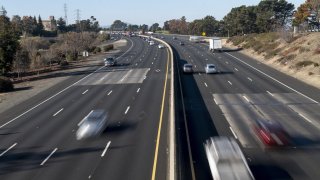COVID-19 already made 2020 a deadly year for Americans, but it turns out the pandemic made roads more deadly as well.
The National Highway Traffic Safety Administration estimates 38,680 people died in traffic crashes in 2020, which would be the highest total since 2007.
The agency highlighted some concerning trends in the data compared to 2019:
- 23% more Non-Hispanic Black people were killed in crashes;
- There were more crash victims between ages 16-44;
- 9% more police reports of alcohol in crashes;
- Plus, 9% more weekend crashes and 11% nighttime crashes, a time period where drinking is common.
The higher death total comes despite fewer people being on the roads - it's because of an increase in risky behavior, NHTSA suspects:
"Drivers who remained on the roads engaged in more risky behavior, including speeding, failing to wear seat belts, and driving under the influence of drugs or alcohol," a statement reads. "Traffic data indicates that average speeds increased throughout the year, and examples of extreme speeds became more common."
It goes without saying that 2020 was a year like no other.
"People were stressed out," said Jake Nelson, director of traffic safety advocacy and research at AAA. "There's lots of stress anxiety about the public health challenges facing our nation, concerns around getting sick yourself, and your friends and family members getting sick and possibly passing away because of COVID-19."
Then there were economic concerns that could lead to coping mechanisms. "Stress and anxiety caters to increased substance use. So it's all kind of tied together," Nelson says.
There isn't one specific reason why 2020 was so different on the roads. It was a mix of changing behaviors like more drinking, higher speeds and less traffic due to the lockdowns and economic downturn, experts say.
"I think there are for sure a confluence of contributing factors," Nelson added.
An economic slowdown doesn't always lead to more dangerous roads. The recession in 2008 actually led to decreased crashes, according to this old NHTSA report.
That report noted that people ages 16-24 (a group of less experienced drivers more at risk of a crash) lost jobs at higher rates during the 2008 recession. Whether they stayed home more instead of going to work, or didn't go out for fun as much due to not having a paycheck, that seemed to have an impact.
One age group that actually fared better on the roads in 2020 was older people. Traffic deaths among people 65 and older were down 9%, likely due to stay-at-home orders and public health messaging that highlighted the virus' danger to the older generations.
Fear of the virus also factored into policing on the roads.
Nelson also pointed out that during the early days of the pandemic, the International Association of Chiefs of Police advised departments to only make traffic stops for the most serious of offenses, to help limit exposure to the virus.
"Those recommendations are public. And so for the motorists who are engaging in those risky driving behaviors during the pandemic, the lockdowns in particular, were aware of the fact that law enforcement weren't going to stop drivers as often and for as many things."
"I think people pretty quickly figured out if you drive really fast, your chance of getting a ticket was probably a lot lower than it was before," said Dr. Jonathan Metzl, a psychologist and sociologist at Vanderbilt University.
But why were fewer people wearing seatbelts?
"It's not like people love wearing seatbelts," Metzl added. "You could think that if we were having the seat belt debate right now, we probably wouldn't be able to pass seat belt laws. People would be saying 'it's my freedom and liberty to be able to sit in a car without a seat belt.'"
"We live in a profoundly libertarian moment....social media has kind of instilled this idea that basically everybody is kind of the maker of their own rules. And that's what made this hard too...There's kind of a lot of anti-authoritarian petulance in the air right now."


